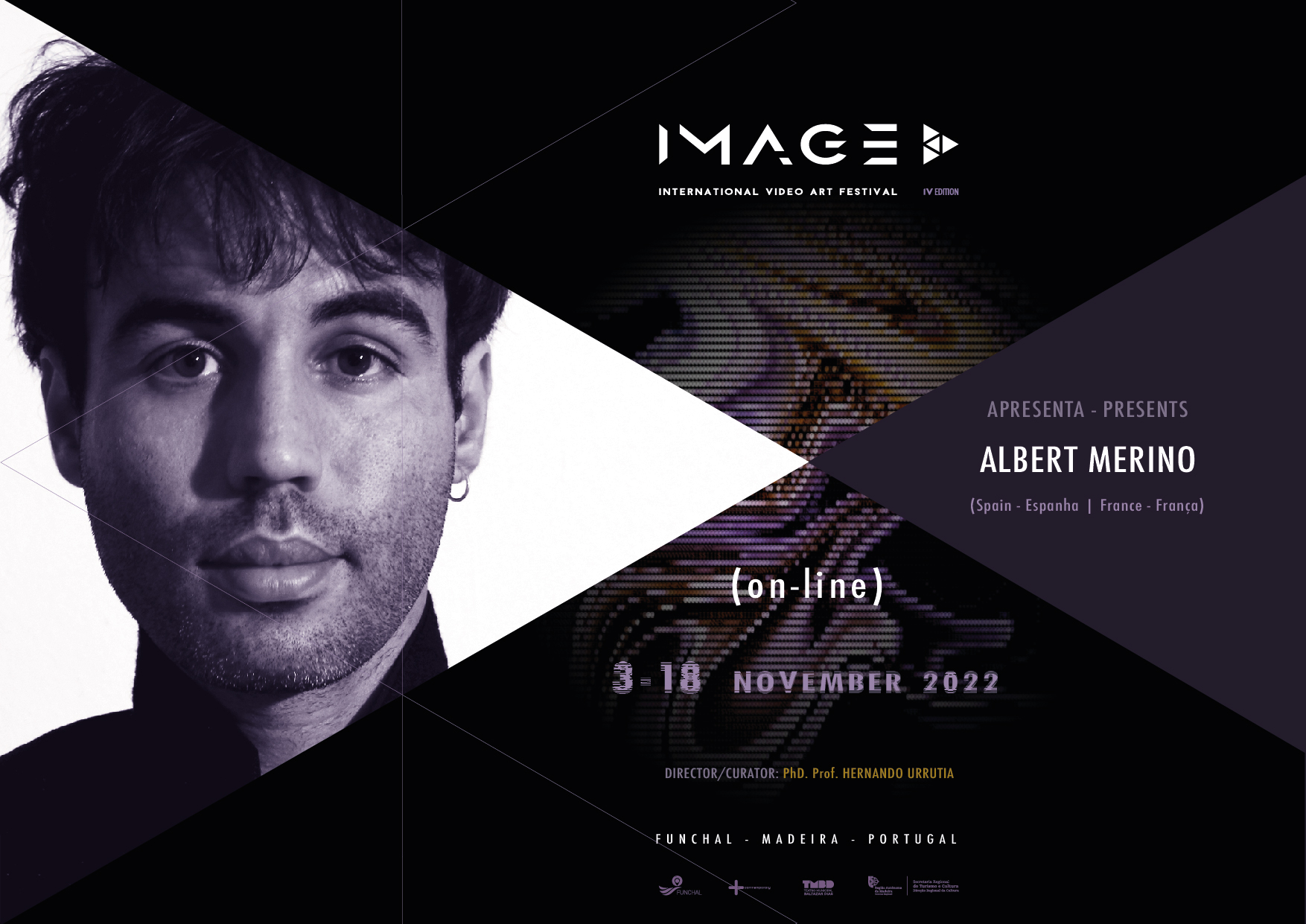ALBERT MERINO
(Spain - Espanha | France - França)

ALBERT MERINO - is Bachelor in Fine Arts from the Universities of Barcelona (UB) and Kunsthochschule Berlin Weißensee (KHB). His artistic work focuses on the field of Videoart
Using a hybrid language, and several graphic resources he develops a wide imagery within he intervenes and transforms reality exploring the borders between simulation and truthfulness. His subjects range from the condition of the individual in contemporary society to the imaginaries of collapse and the political use of symbols and images
His work has been shown in a big number of international festivals and has been presented in institutions and museums such as Arts Santa Mònica (Barcelona), Académie de France, Palais de Tokyo (Paris), Les Abattoirs (Toulouse), MEIAC (Badajoz), Nam June Paik Art Center, Songwon Art Center (Seoul), MOCA (Taipei), among others as well as in art fairs like Los Angeles Art Fair, Beijing Art Fair, ARCO, or Art Basel Hong Kong. In his career, it is worth highlighting the individual exhibitions in the Trapezio space (Madrid), the IMA creative space (La Paz), the Chapel of Pronillo (Santander), Espai Souvenir (Barcelona) or his participation in group exhibitions at the Alternative Loop Space (Seoul), Galleria Boccanera (Trento), C1 Espace (Berlin), Sant Andreu Contemporani (Barcelona), CCCB (Barcelona), DIAS Kunsthal Vallensbæk (Denmark), Corner Gallery (Madrid) or the biennials of Wroclaw, (Poland) or Cerveira. (Portugal). His carrier has been recognized with several international awards.
TÍTULO - TITLE
MEMÒRIA DEL DESPRENIMENT
DURAÇÃO - TIME
10'00''
ANO - YEAR
2021
PAÍS - COUNTRY
(Spain - Espanha | France - França)
FORMATO - FORMAT
16:9
7-1S MEMÒRIA DEL DESPRENIMENT - Albert Merino 1ª SESSÃO | 1st SESSION
IMAGE PLAY ► International Video Art Festival - IV Edition 2022 (Funchal, Madeira - Portugal)

CREDITS:
Albert Merino
+ Atores/Actors
Debora Gaseni, Carles Isern, Muntsa Garcés, Miquel Oller
SYNOPSIS:
MEMÒRIA DEL DESPRENIMENT: Detachment refers us to material and affective, associating both emotional and physical. The Detachment may become a gesture of pain but also necessary, in the same way that the imaginaries of collapse does not necessary imply an end but a desired beginning.
In the Memories of Detachment, the Collapse is shown as the appearance of unspecific elements who will appropriate the space of the city. These elements respond to collective imaginaries that reveal us details of a society's behaviour.
These cultural imaginaries are build based on real or manipulated images that have been agreed socially. They are direct related with the evolution of the image technologies and the capacity to record and manipulate then. Collective and social imaginaries are constructions who can articulate political narratives and serve as a justification. What role do we attribute to these imaginaries of collapse and in which way they justify the control devices? In the architecture of the collective narratives the fantastic is replaced by the possible.
The elements of the video work as metaphors of the accumulation of information and knowledge, and the rise of entropy or decay; using a plot that unveils us the contemporary scenarios of overflow.
TÍTULO - TITLE DURAÇÃO - TIME ANO - YEAR PAÍS - COUNTRY FORMATO - FORMAT
IMAGO TYPHONIS 10'00'' 2016 (Spain - Espanha | France - França) 16:9
18-2S IMAGO TYPHONIS - Albert Merino 2ª SESSÃO | 2nd SESSION
IMAGE PLAY ► International Video Art Festival - IV Edition 2022 (Funchal, Madeira - Portugal)

CREDITS:
Albert Merino
+ Atores/Actors
Silvia Heras, Albert Merino, Hélène Damville, Baptiste Fompeyrine, Julieta Miranda, Pierre Primetens, Marco, Michela Aielo, Rebeca Herreros, Mario Espliego, Mireya Martín, Jennifer Moule,Tania Blanco.
Local de Gravação - Recording: Location: Bolivia, Argentina
SYNOPSIS:
IMAGO TYPHONIS: In 1637, the Augustinian Fernando Valverde wrote a poem about the Sanctuary of Copacabana in which he equates Greek-Latin iconography with Andean stories in search of coincidences and analogies. By appropriating foreign cultural references to explain one's own, we can ask ourselves if we are not rather trying to understand the foreign through our a prioris. Using one's own referents to explain difference is in itself an entelechy and an impossibility. Imago Typhonis' is a reflection on this impossibility and takes the opposite route by explaining foundational myths through displaced imaginaries that are far removed from their original meaning. Among the different snapshots we can find a hypothetical reconstruction of the labyrinth of Chinkana, a historical construction located in the interior of Lake Titicaca, now in ruins.
.

